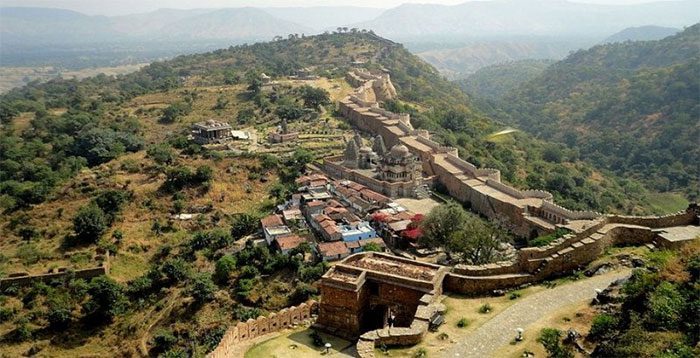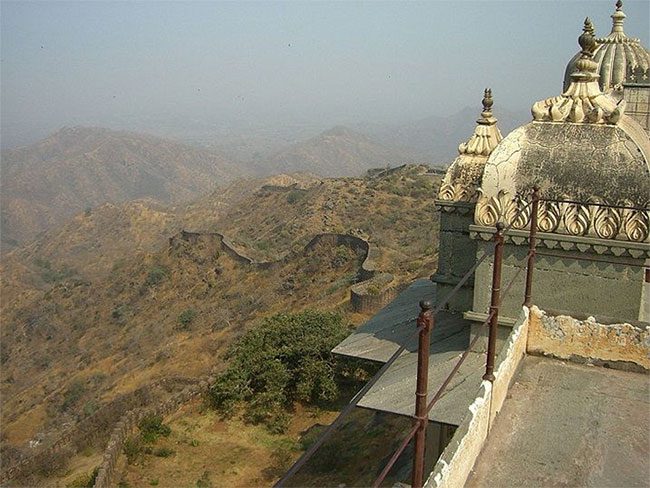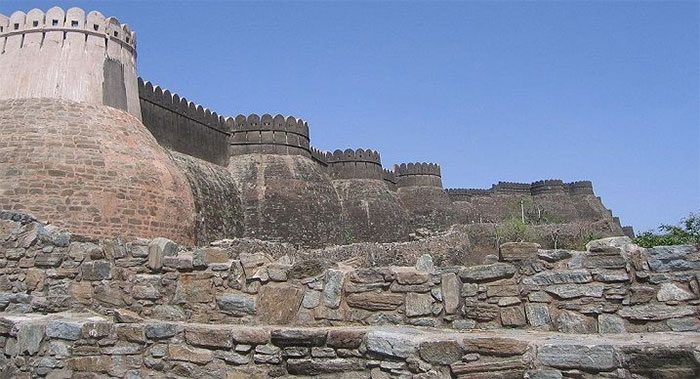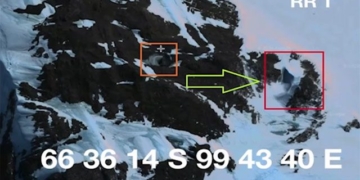The walls surrounding the ancient Kumbhalgarh Fort are among the best-kept secrets in India and perhaps the world.

Inside the Kumbhalgarh walls lies a massive fort housing over 300 ancient temples. Historians believe this remarkable wall was constructed by Rana Kumbha in the 15th century.
Commonly referred to as “Kumbhalgarh Wall” or simply “Kumbhalgarh Fort“, this wall is often likened to the Great Wall of China. The wall stretches over 36 kilometers around the fort’s perimeter, making it the second-longest continuous wall in the world after the Great Wall of China.
Standing majestically on a high ridge at an elevation of 1,100 meters (3,600 feet) above sea level, it symbolizes the glorious past of the Rajput rulers. The wall, which winds through cliffs and valleys, is an excellent example of the brilliant architecture of the Rajput era, evidenced by the fact that it remains intact and in good condition despite being around 700 years old.

This wall was initiated by King Rana Kumbha in the 15th century. In 2013, Kumbhalgarh was recognized as a World Heritage Site by UNESCO. However, many people still remain unaware of this ancient fortress for various reasons, despite its massive scale and beautiful architecture.
Kumbhalgarh is located in southern Rajasthan in western India. During Rana Kumbha’s reign, the kingdom of Mewar expanded from Ranthambore to Gwalior, encompassing vast territories that are now part of Rajasthan and Madhya Pradesh. Of the 84 forts under his dominion, Rana Kumbha is said to have designed 32 of them, with Kumbhalgarh being the largest and most elaborate. This fort was built as a refuge for the Mewar rulers during times of conflict.
The grand wall built around the fort was designed to protect it from invasions, winding through valleys and along mountain tops. Although in some places the walls appear quite thin, in others they are over 15 feet wide and constructed beautifully with thousands of stone bricks and decorative patterns along the top.

Kumbhalgarh is an ancient fort protected and surrounded by massive walls, situated atop a high hill, providing a significant advantage for observing distant disturbances. There are a total of seven gates strategically located around the fortifications.
The fort is also protected by 13 peaks of the Aravalli Range. Visitors can enter the fort through any of the seven gates known as: Aret Pole, Hanuman Pole, Ram Pole, Vijay Pole, Nimboo Pole, and Bhairon Pole.
Within the fort’s premises, there are over 360 temples. Approximately sixty of these are Hindu temples, while the others are Jain temples.
It is said that during Rana Kumbha’s time, the walls were adorned with numerous lamps consuming about 50 kg of buffalo butter (oil) and 100 kg of cotton to illuminate the farmers working throughout the night in the valley.

According to Narayan Vyas, an archaeologist who has conducted several investigations of the walls between Bhopal and Jabalpur, he believes that the ruins of the ancient temples and walls may be even larger than what many historians have recorded.
The fort is also known for its famous palace located at the top of the architectural complex. This beautiful palace is called Badal Mahal or “Palace in the Clouds.” It is also recognized as the birthplace of the great warrior Maharana Pratap, one of the greatest kings of Mewar.
It is said that the history of the Kumbhalgarh Fort dates back to the 2nd century during the Mauryan era of ancient India.
However, despite its size and history, the Great Wall of India is hardly known outside the region.

Although construction began in the 15th century, Kumbhalgarh continued to be expanded and completed until the 19th century. While many mysteries still abound and lively debates among historians may have just begun, local residents take great pride in, revere, and boast of this magnificent structure with its stunning architecture.
This fort was added to the UNESCO World Heritage List in June 2013 along with five other hill forts of Rajasthan.
In fact, this wall continued to be expanded until the 19th century, and the fort is now open to the public. It is the most important fort in Mewar after Chittorgarh. The fort also offers panoramic views of the surrounding countryside. From the fort’s summit, one can see the breathtaking scenery of the walls encircling the fort amidst the Aravalli Range. The dunes of the Thar Desert are also visible from the walls.
Tourists are advised not to climb some less-frequented areas of the wall. Ancient traps and defensive mechanisms, although mostly deactivated, are believed to exist in some more remote locations. Those wishing to explore the miles of ruins on their own should be warned that accidents may occur.




















































